I eat a LOT of oats. They’re cheap, filling, nutritious, and can be prepared a variety of ways. What’s not to love?
Sure, a lot of people have not-so-fond memories of gluey, tasteless oats that were fed to them as a child, but I’m here to tell you that not all oats are created equal! Depending on what type of oats you buy and how you prepare them, oats can take on several different flavors and textures. So, which type is best to use? That’s up to you. I’ve prepared a guide below to help you differentiate between some of the more common oat varieties, how to cook them, and how they can be used. Enjoy!
A Beginner’s Guide to Oats
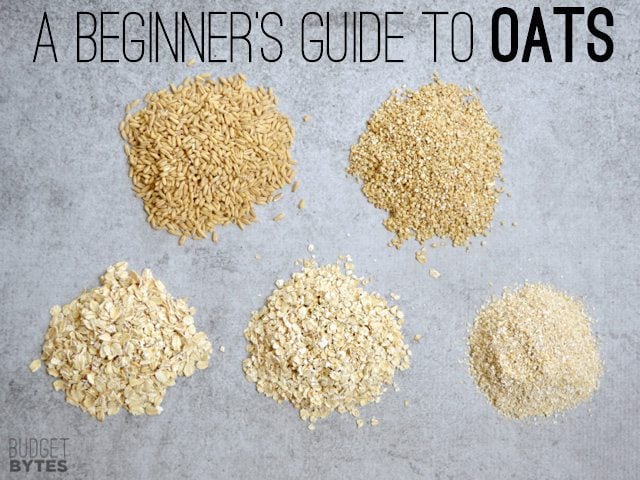
I took a quick trip to Whole Foods today and picked up several types of oats: whole oat groats, steel cut oats, rolled oats, quick oats, and oat bran (from top left to bottom right). Buying your oats from bulk bins is usually far less expensive than buying packages or canisters of oats (my local grocer had a large container of rolled oats priced at over $5! Eek, too high!!). Buying oats in bulk and storing in reusable containers uses less packaging and you can even purchase reusable (and washable) bulk food bags to use instead of the plastic bags provided by the store.
On to the varieties….
Description: Groats are the whole oat berry (just like a grain of rice, barley, or wheat berry) that has had the tough hull removed. The bran and germ are intact, making this type of oat very high in fiber and nutrients.
Cooking: Because these oats are whole and protected by the bran, they take the longest of all the varieties to cook. Soaking the groats for at least one hour or over night before cooking is recommended. Once added to boiling water, soaked groats will need 45 minutes to one hour to fully cook. Stove top cooking instructions can be found here. Groats can also be cooked in a slow cooker, rice cooker, or dutch oven.
Oat to Water Ratio: 1 part oats to four parts water (1:3 ratio for a less creamy and more rice like finish).
Uses: Groats can be eaten for breakfast like other oat varieties, but their rice-like texture also makes them great for pilafs and salads, similar to how wheat berries or barley is used. Groats can also be ground at home, providing you have a grain mill, into steel cut or whole grain oat flour.
Description: Steel cut oats are essentially whole oat groats that have been chopped into pieces (but not rolled). This type also contains all of the bran and germ and is also high in fiber and nutrients. Because the starchy center of the oat berry is exposed, they cook slightly faster than groats and create a creamier texture. Steel cut oats come in a variety of sizes, some more finely ground than others. Steel cut oats are also known as Irish oats or Scottish oats, with Scottish oats being ground a bit finer.
Cooking: Steel cut oats do not need soaking, but still require about 20-30 minutes of simmering on a stove top to fully soften. Cooking steel cut oats in slow cookers or rice cookers is a convenient way to take the effort out of the process. Make your steel cut oats in large batches and reheat individual portions throughout the week for a quick breakfast.
Oat to Water Ratio: 1 part oats to 4 parts water (1:3 for a thicker, less creamy finish).
Uses: Steel cut oats are most commonly eaten for breakfast, although savory preparations make a great alternative to polenta or other grain porridges.
Why I Love Them: They have a much nuttier flavor than rolled or quick oats and tend to keep me full longer. The chewy texture of the oat bits are fun to eat and remind me of tapioca.
Description: Rolled oats are whole oats that have been steamed, rolled flat into flakes, then dehydrated. The steaming process partially cooks the oat, so the final cooking process is much faster (think regular rice versus instant rice). Rolled oats still retain a lot of the bran and are fairly high in fiber. Exposure to steam and oxygen during processing causes many of the delicate nutrients to be lost. Rolled oats are also called “old-fashioned” rolled oats and may come in a variety of sizes and textures, but in general the rolled flake is left whole.
Cooking: Rolled oats cook extremely fast compared to steel cut, requiring only about 3 minutes in the microwave or 5-10 minutes of simmering on the stove top. The highly exposed starch makes a soft creamy texture once cooked.
Oat to Water Ratio: 1 part oats to 2 parts water.
Uses: In addition to the obvious hot breakfast porridge, rolled oats can be incorporated into breads and other baked goods for added texture. They make a great decorative topping for muffins and bread, and can even be baked into breakfast oat casseroles.
Why I Love Them: This is my favorite type of oat because they’re fast to cook but still provide a lot of texture. I love the juxtaposition of the chewy flakes and creamy oat starch.
Description: Similar to rolled oats, quick oats are steamed and rolled into flakes, but are then chopped into small pieces before dehydrating. The longer steaming process and smaller pieces allows these oats to cook extremely fast. The more extensive processing also means less fiber and nutrients are retained. Instant oats, which are a type of quick oats, are processed even further and only require the addition of hot water to rehydrate.
Cooking: Quick oats only take about one minute in the microwave or a few minutes on the stove top to rehydrate. They create an extremely creamy oatmeal, that can sometimes be interpreted as gluey. To prevent the gluey texture, make sure to add enough liquid before cooking. Too little liquid and the oats will be stiff and sticky. Adding more liquid will loosen them up and create a nice creamy oatmeal.
Oat to Water Ratio: 1 part oats to 2 parts water.
Uses: Like rolled oats, quick oats can also be added to breads and baked goods although they’ll be less noticeable in the end product. Quick oats are also great for use in skin treatments because the soothing starch is very exposed and reconstitutes easily with water.
Why I Love Them: They’re the creamiest! I usually love rolled oats the best, but there is an undeniable deliciousness about the super creamy quick oat. Plus, they’re fast. Who doesn’t love that?
Description: Oat bran is the fibrous outer coating on the oat berry (think of the thin papery coating on peanut). This stuff is straight up fiber and is a byproduct of the oatmeal making process. Luckily, some of us want the oat bran, so it’s packaged and sold rather than discarded.
Cooking: Oat bran is most often used as an additive or supplement to other foods, but can also be mixed with hot water to create a porridge similar to Cream of Wheat.
Uses: Oat bran is used to add fiber and texture to other food. It’s what makes oat bran muffins so deliciously nutty. You can add extra oat bran to your regular oatmeal, other breakfast cereals, yogurt pilafs, breads, and other baked goods. It has a slightly nutty flavor.
Why I Love It: It’s cheap and instantly increases my daily fiber intake. Win-win.
Since I had all these oats on hand, I decided to cook a few of them up so that you can see the difference in the texture once cooked (from top to bottom: steel cut, rolled, quick). Like I mentioned before, the steel cut oats make these really nice chewy little pieces that remind me of tapioca. Super fun to eat and quite filling. The rolled oats are kind of flakey, but still have a lot of creaminess about them – they are my favorite! The quick oats are just all around creamy, not much texture aside from that. Again, quick oats can get gluey if you don’t use enough water, so make sure to use a 1:2 ratio of oats to water. If they still end up getting dry or stiff, you can stir a little extra hot water or milk in to loosen them up.
So, let’s hear from you! Share your favorite type of oats and favorite way to eat them in the comments section below.


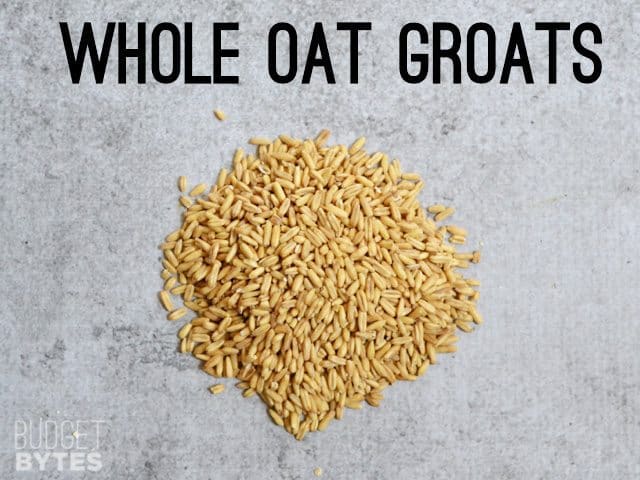
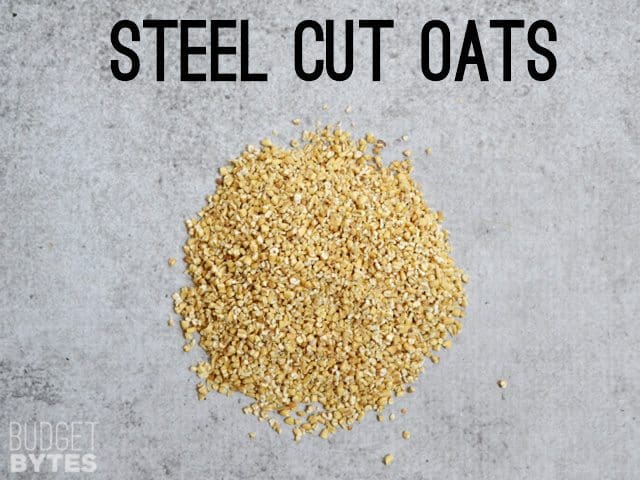
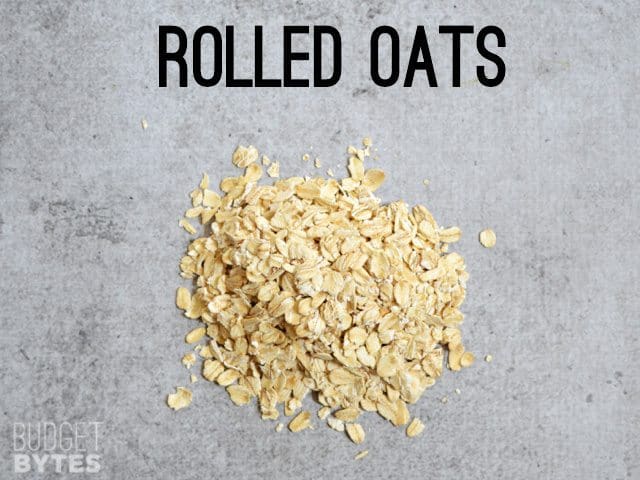
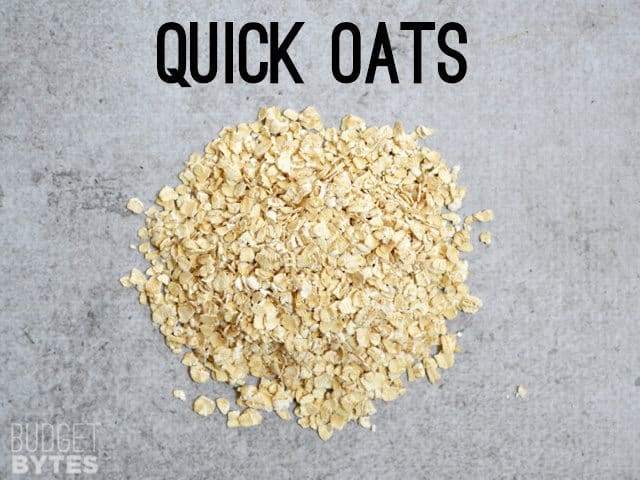
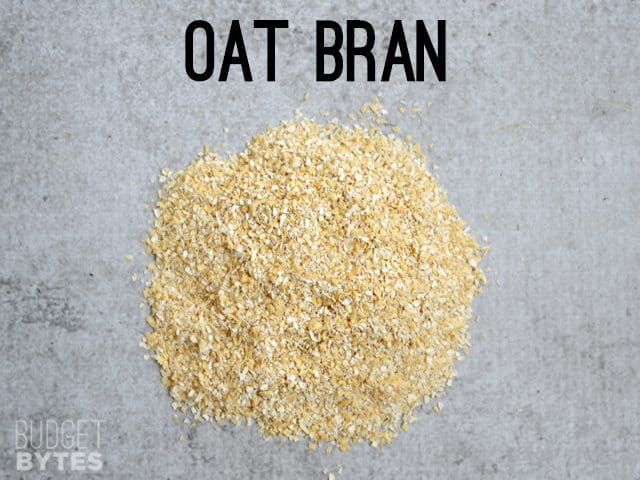
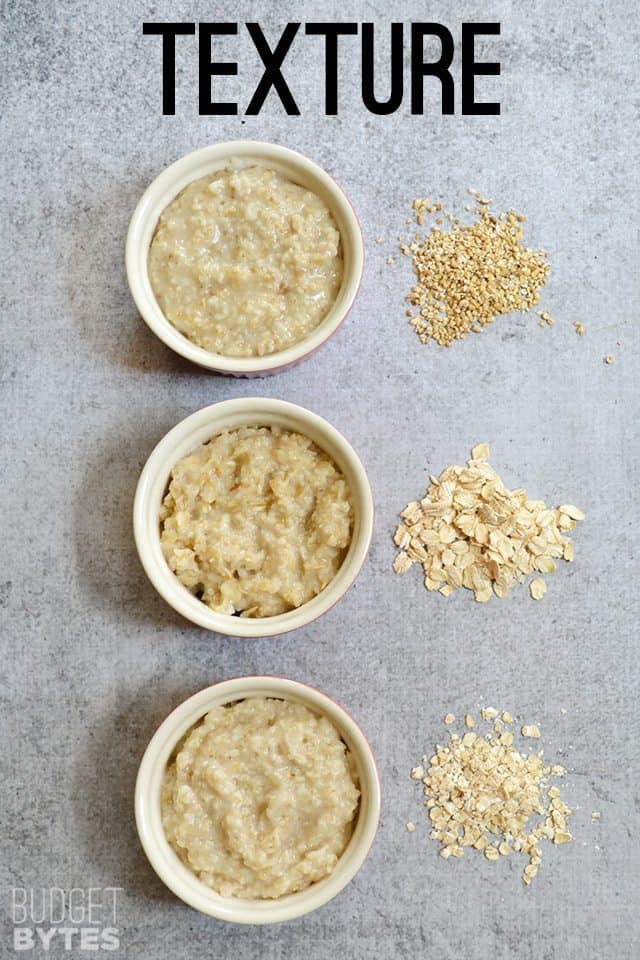
Thanks for explaining this!
ThAnks very informative!
Any suggestions on how to make oat milk?
Hi Kim. Blend 1 cup of rolled oats with 4 cups of water in a high-speed blender for about a minute, then strain through a fine mesh sieve or tightly woven clean cloth.
Wow!!! This is incredibly helpful! Answered a lot of questions I’ve had! :-)
I eat rolled oats after soaking overnight in the fridge in almond or flax milk with dried/dehydrated fruit. I add nuts and whole fruit in the morning, whatever I have in my fruit bowl and any seasonings that may pair well, like cinnamon. I also use coconut nectar as a sweetener. Adding it the evening before with the milk really saturates to oats. I even added a chocolate protein shake one morning when the oats were a bit dry and I was going to kickboxing. The mix ins are limitless!
This may sound strange, but I love cooking oats (any variety) in chicken broth with a little butter. Normally I get strange looks when I say this because oats are normally prepared with some kind of sweetener, but this method is extremely satisfying and comforting. Kind of like chicken noodle soup in a way.
I recently purchased a big container of old fashioned oats at Walmart for $2.00, so I’m looking forward to making baked oatmeal for breakfast. It’s nice to have something filling to eat for breakfast without trying to figure out what to eat. I’ve made three of your baked oatmeal so far, but my favorite is the Sweet Potato Casserole Oatmeal. :-)
I used to only eat steel cut oats, but living on a grad student’s budget has changed all that. Now I buy store brand rolled oats b/c they’re a lot cheaper than the steel cut that are available locally. I’ve really been enjoying them with a chopped banana, some unsweetened coconut, and a bit of brown sugar.
Also, I’m a huge fan of barley. I used it in my take on your Mujaddara, and it makes an even better version of rice pudding because it’s sweeter. Ironically, the cheapest place to get it in the town where I attend school is the little natural foods store that’s normally twice as pricey. A full dollar less per pound!
Loving oat bran lately. Cook it with water for a few minutes, add a splash of milk, candied pecans or walnuts, and either banana, frozen or fresh berries. Rotate with steel cut every so often. Only kind of oat I don’t like is the mushy instant, or any overcooked gluey mess- I like it loose and almost watery!
I’ve been obsessed with it since writing this post, too. I just LOVE the texture and it’s higher in protein and fiber than regular oats, so it’s like a win-win-win!
I eat steel cut with flax seed meal for breakfast every morning. I cook it at work, where I only have a microwave. It took me a long time to find the right recipe and cooking time and temp, but here’s what works for me.
4 cup measuring cup
1 1/2 cups water
1/4 cup steel cut oats
2 tbsp flaxseed meal
1 tsp brown sugar
1 tbsp maple syrup
Microwave for 20 minutes on 40% power. It won’t boil over at that setting.
I also mash up a spotty overripe banana with a dash of whole milk and stir that into the finished oatmeal. I eat that at 8 am and I don’t need lunch until 2 pm.
Super weird, but I love rolled oats in cold almond milk and a bit of sugar. I like that it has a slight crunch instead of being creamy.
I’m a big fan of the “old-fashioned” rolled oats. I sometimes eat quick oats too (because they’re so quick, which is handy for the mornings before work) but don’t particularly like the texture.
Very helpful post! Do you know if farro and groats are the same thing? I made a farro tomato dish recently and it was delicious. It was my first time cooking with farro.
Farro is a different grain. I haven’t experimented with it yet, but I’ve wanted to!
Thank you for doing making this so simple :) Appreciate what you share!
I make my own instant oatmeal with Quick Oats. 1/4 cup quick oats, 2 Tblsp. powdered quick oats(process in food processor or blender), 1 Tblsp. Brown sugar, and a dash of salt. I make up 8 individual servings and store in glass jars in the pantry. Add boiling water and stir and I have oatmeal. Sometimes I will add Craisans and/ or a few walnuts.
I’m not a big fan of oats except in cookies, granola and so on. But I love April Bloomfield’s porridge.
http://www.thewednesdaychef.com/the_wednesday_chef/2013/03/april-bloomfields-porridge.html
Thanks so much for making this post! It really does help me understand how to buy and cook oats!
I love using steel-cut oats in my granola—I swap out half the rolled oats for steel-cut, and I feel like it fills me up great with yogurt. I love the idea of adding them to smoothies, but I’ve always been too intimidated. Should I just throw them in with everything else, or do I wait until the end when everything else is blended? I imagine they would change the moisture and texture of the overall smoothie.
I’ve added rolled oats to smoothies (just add it in before blending) and it makes a really nice, thick, filling smoothie. I don’t know how steel-cut would work, though. They seem like they’d be too hard?
I just love oats! I use them in both my summer and winter weekday breakfasts. During the summer I add quick oats to my smoothies for fiber – it fills me up! For the winter, I make a big batch of steel cuts oats with apples and cinnamon for a hearty breakfast all week long. And on the the weekends, I often treat myself to your whole wheat oatmeal pancakes :) They are my favorite! Thanks for all the great recipes.
What about oat fiber? That is a new one for me but I’ve seen some recipes using it.
I’m think that’s just another name for oat bran? Unless they somehow extract the soluble fiber from oats, which I guess is possible.
I use a lot of oats because they are healthy and frugal. We eat both rolled and steel cut for breakfast. I grind groats into flour for breads, cookies, muffins, etc. Thanks for the info and the great pics!
I use a ton of oats because they are frugal, healthy, and very versatile. We eat rolled & steel cut for breakfast. I grind groats for flour, and I make a lot of cakes, cookies, breads, muffins, etc. with rolled oats. Thanks so much for the info and the great pics!
This is a great roundup of the different type of oats! I almost always eat rolled oats because I like the “coarser” texture over quick oats, but they don’t take too long to cook, either. Plus, they’re so versatile because I bake with them, and grind them up into a flour!
I often make a small cup of oatmeal (old fashioned rolled oats) first thing in the morning with a 1/2 spoon of nut butter and honey or maple syrup…sometimes a spoon of shredded coconut. Something in my stomach while I do morning stuff and then I have a late morning breakfast.
I found I didn’t care for steel-cut as a cereal/porridge, BUT I make a no knead bread that is 2/3 white flour, 1/3 wheat flour, steel cut oats, flax seed and sea salt. (typically my mix is: 260 grams white, 130 grams wheat, 1/4 cup oats, 1 T flax seed and 3/4 T salt, 2.5 tsp instant yeast and nearly 2 cups warm water – this is for my WheatMT hard red wheat flours) The high moisture and long rise of no knead handles the steel cut oats and it makes a wonderful crusty/custard crumbed bread.
Awesome, I want to try that!
I definitely prefer the steel cut oats for texture and flavor. I like to mix in fresh peaches and a little bit of whole milk yogurt to make it extra creamy once it’s done cooking.
I have an easy, low fat refrigerator recipe that involves soaking two cups of whole wheat Quaker Oats with two cups unsweetened almond milk and a pinch of salt overnight in the fridge. It’s meant to be eaten cold and I sweeten it by topping a serving with frozen blueberries. It’s a great cooling breakfast for the summer.
I was wondering if the same process (adjusting for the oats) could be used for steel cut oats.
Thanks for the post! I enjoy rolled oats as porridge and baking them. I’ve also been using the same process for oat bran as well. I also enjoy the “smoothie in a bowl” recipes from the blog “Kath Eats Real Food”.
Can cooked oats be frozen into individual containers? It would be great to be able to have a some on hand for those busy mornings!
Yep, they sure can! I like to add a splash of liquid before reheating, though, just to loosen them up.
This is really helpful. It can be really confusing when you go to a store in Whole Foods and there’s just too much choice!! My favourite thing to do with oats is to mash them with banana and make healthy cookies!
I love steel cut (also known as pin-head in the UK) best, cooked in water with a pinch of salt and served with milk (or cream if decadent) and dark brown sugar. A lot of this is pure nostalgia for how my granddad did his porridge. I wish it was winter now so I could eat porridge again! Unfortunately steel cut oats are quite hard to find in the UK, you can’t even rely on all health food shops to stock them. :(
The other great use for rolled oats is flapjacks (I think they’re called granola bars in the US).
I don’t know for sure about oat bran, but wheat bran is great mixed with natural or greek-style yoghurt (or fromage frais), left for 5 mins and then add some blueberries or raspberries.
I always hated oatmeal- I preferred to eat raw oats (I also prefer dry cereal) but I may have to try a ‘breakfast pasta salad’ like that earlier comment said!
OATS!! I love oats. I especially love raw rolled oats with dried fruit and nuts (muesli) with yogurt for breakfast. Making it at home creates something not even in the same ballpark as the Swiss brand version. Plus I think it’s cheaper (see description of bulk oats, above). European countries usually have this at grocery stores, but I almost never see it here in the US.
Yes, muesli is my favorite breakfast, too! :D So cold and refreshing. :)
I like my steel cut overnight oats. One part oats to one part liquid (usually soy milk for me, but you can use milk, yogurt, or water) plus whatever mix ins you want and soak overnight. They are basically “cooked” in the morning and then you can eat cold or warm them up. I usually mix in chia seeds (plus a little extra liquid since they will speak some up), nuts, sugar, and cocoa powder. I like to call it cocoatmeal. ;-)
LOVE THIS! I have heard of almost all of these (not so much the groats) but never knew the difference. I think I usually get old fashioned- but I might take the plunge and try steel cut sometime! Thanks for taking the time to compare & contrast all of these– awesome post, Beth!! :)
If you’re using a British recipe, particularly a Scottish one and you see a reference to oatmeal, we don’t mean breakfast, we mean what you call steel cut oats. If you were making oatcakes from scratch that’s what you’d use. We also use oatmeal in savoury dishes like stuffings & it’s one of the main ingredients in haggis.
Steel cut! I make a big batch at the start of the week, and go savory: sauté some mushrooms, onions, spinach, throw in the oats with a bit of parmesan and maybe a little shoyu or sriracha. I’m I starving, a poached egg on top.
Savory is now my favorite way to eat oats in the morning, in spite of growing up as a maple syrup, raisin, and cinnamon girl.
Hooray, oats! I always have a lot of bulk bin rolled oats on hand, and make oatmeal on the slightest of provocation. :) I think the key to good oatmeal is to actually salt it — my mom never did when I was growing up, and I thought I hated oatmeal for a really long time. But with salt and a little butter? SO good.
Thanks for this. I bought a big bag of oat groats last summer, but was clueless as to how to prepare them. Ultimately, I would soak some over night, then rinse them and mix them up with sliced peaches, chopped walnuts and almond milk for breakfast. It was kinda like a breakfast pasta salad. I loved it.
Oops, I also boiled them for about tem minutes after the soaking, then rinsed them till they were cool.
You forgot to mention that consuming whole oats or oat bran has been shown to lower the risk of cardiovascular disease and colorectal cancer. this has to do with the peculiar kind of fiber found in oat bran and not in others sources of fiber.
It’s true that you don’t have to soak steel-cut oats, but I still find it convenient to do so. I parch two cups of oats (some of Beth’s other recipes made me realize that all grains taste better if you parch them before you cook them), add 4 cups of water, bring the whole thing to a boil, remove from the heat, cover, and leave to soak overnight. in the morning I have a week’s worth of breakfast all cooked — just dish it out and reheated in the microwave. Tastier and healthier than rolled oats, and actually less work.
I’ve never been a huge fan of porridge (especially not with sweet things in it), but I do like to take steel cut oats, toast them in a dry frying pan, and cook them as a pilaf.
Oh man, I didn’t know that oat bran wasn’t usually eaten by itself. I do make oat bran muffins, but my dad, and now I, have been eating oat bran for years for breakfast. For some reason I hated cream of wheat as a kid, but I loved me some oat bran.
I prepare by bringing 1/2 c water, 1/2 c almond milk to a slow boil, then stir in 1/4 c oat bran. Then I reduce the heat to low and cook covered for 5 minutes. Then off-heat, I throw in additions (cinnamon and mashed banana for sweet, nutritional yeast and tamari for savory).
Maybe I was wrong! :)
I grew up eating oat bran as hot cereal as well. We always made it with 100% water, but other than that, it was about the same method.
I also eat oat bran instead of cream of wheat! Usually I make it savory with butter and cheese… kind of like grits but a little healthier/more fiber-filled I think.
After reading this yesterday, I tried oat bran with almond milk/water. After I cooked it I added cinnamon, a bit of sugar, and a heaping teaspoon of peanut butter. It was great!
For porridge, I strongly prefer steel-cut. I use the Cook’s Illustrated method. Bring 3 cups of water and 1/2 tsp of salt to a boil. Off-heat, add 1 cup steel-cut oats, cover, and let stand at room temperature over night. In the morning, add 1 cup water. Bring to a boil and cook 5 minutes. Turn off heat, let stand 5 minutes more, and serve. I’ll sometimes use half orange juice in the morning step, and add a handful of dried cranberries, to make cran-orange oatmeal. You can add whatever your favorite add-ins might be (brown sugar, maple syrup, raisins, chopped fruit, cream, chocolate chips – I’ve even seen soy sauce and chopped scallions).